Setting the Standard for Gen Z

Written by Fran Smith (BGN’s Gen Z’er)
Gen Z is the generation born between 1996 and 2010. Not only are they the best-educated generation but the most diverse. Gen Z’ers aren’t afraid to speak their minds and tackle social issues head-on. They grew up during the rise of social media platforms, from Facebook to Instagram and most recently to TikTok. Making them true digital natives with a life-long experience of technology.
They have a ‘keep it real’ attitude and look for brands that emulate this. With a craving for authentic brands that break through the over-saturated market and demand attention.
From childhood nostalgia to maximalism; here’s how five Gen Z brands are Setting the Standard.
A make-up brand bursting with fun and a hint of childhood nostalgia.

This brand would bring out anyone’s inner child.
A key feature of the product design is the interlocking lipsticks and plastic platform, which feel reminiscent of Lego. Like Lego customers are encouraged to be playful with the product by creating combinations and collecting.
The branding uses a ‘maximalism’ clashing colour palette with fluorescent yellow, blue, purple, pink, and white all used in equal measure. The typographic language is equally as bold with both condensed and extended typefaces used together throughout.
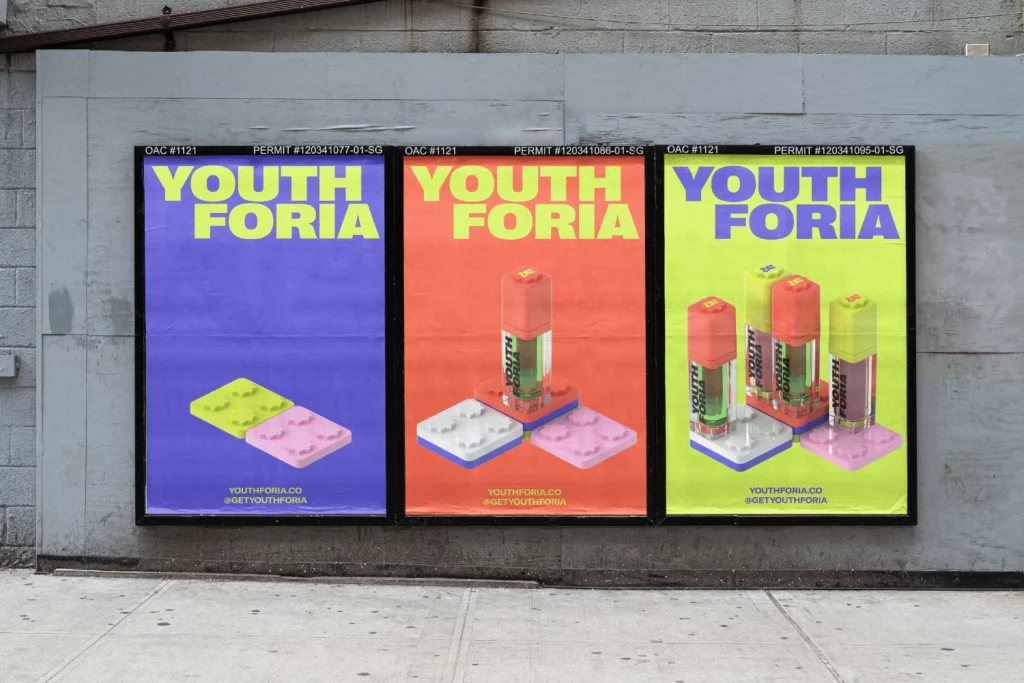

A video-based fashion marketplace that demands your attention.
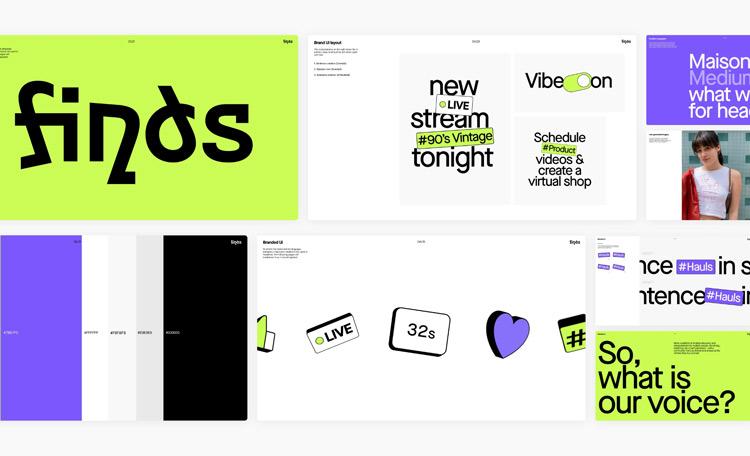
Finds aims to re-brand thrifting as a new form of self-expression away from the idea of a dusty charity shop and into the digital video first space.
It uses a striking colour palette with the use of fluorescent yellow and bright purple. Post-pandemic there seems to be a strong desire for colourful maximalism. While the colours are bold the brand still feels clean and digestible.
The energetic typographic mark is memorable and unique conveying a sense of movement even when static representing the ever-moving world of fashion reselling. The playful illustrations are also reminiscent of emojis a visual language Gen-z obviously knows well.
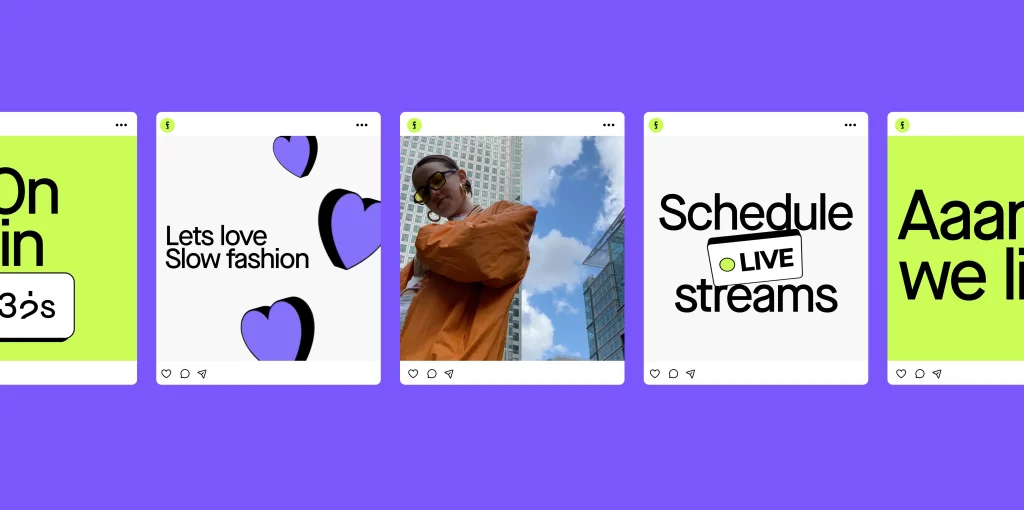
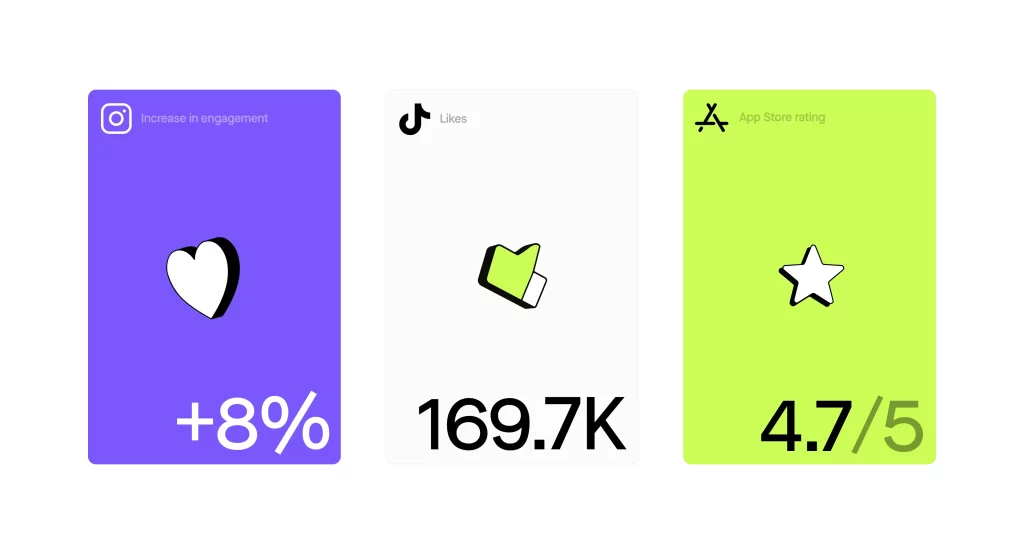
Putting the MAX into maximalism.
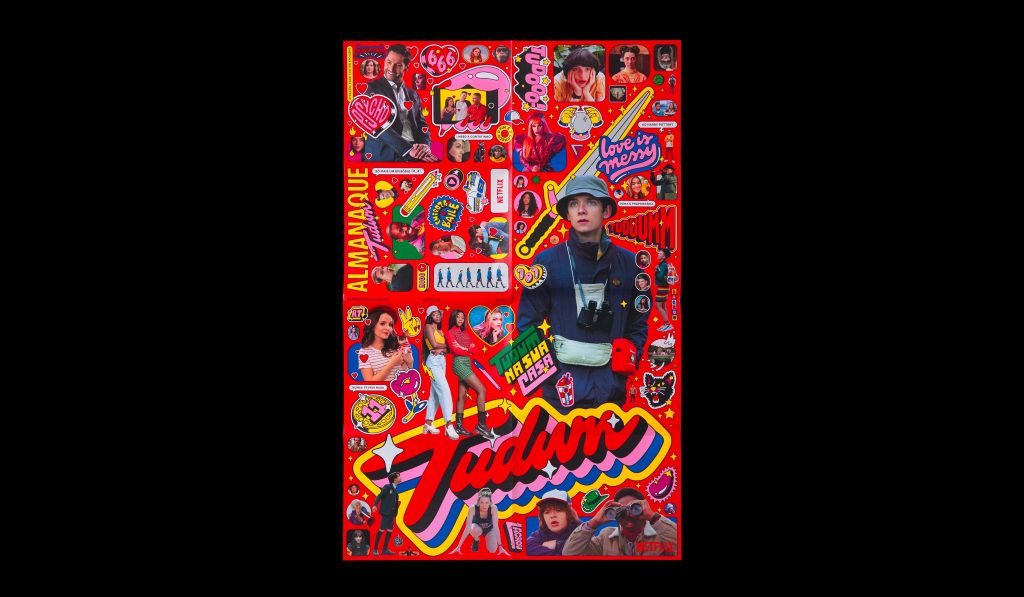
Netflix did not hold back on the branding for Brazil’s Tudum, a four-day festival that due to the pandemic couldn’t go ahead in person. So, they created a 116-page almanac for the fans.
The branding is made up of layers of sticker designs, every time you look you see something new. The typography is striking with exaggerated drop shadows along with lots of loud layers of type and photography reminiscent of 90s teen magazines.


Rebranding acne from shameful to Instagrammable
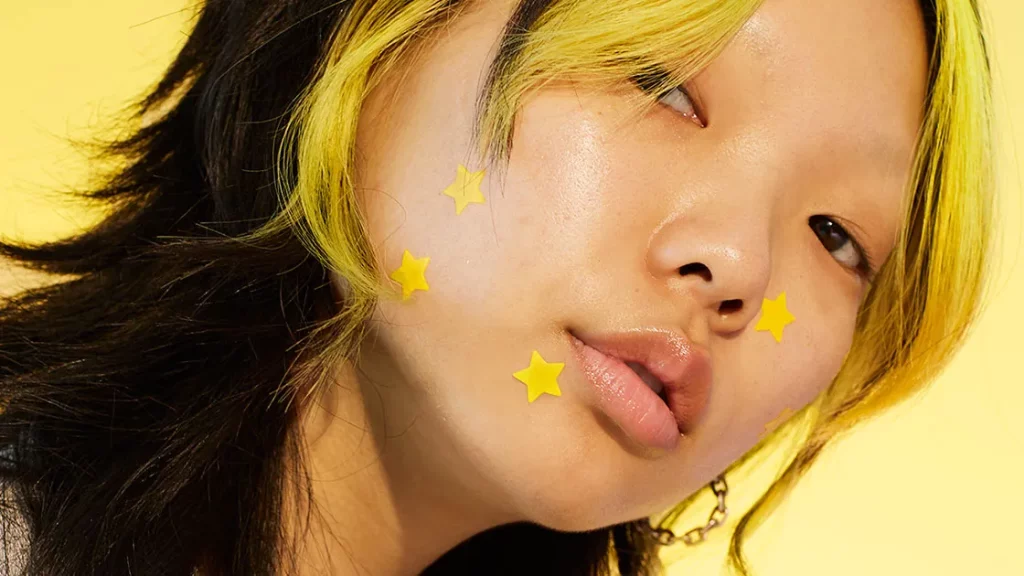
StarFace’s brand mission is to remove the stigma around acne and make it fun, something to embrace, undeniably subverting social norms.
The brand’s main product is fun little sticky hydrocolloid star pimple patches that can heal and hide your acne simultaneously. The design resembles a gold star you’d get as a kid in primary school or ones you’d get free in magazines. The body copy is reminiscent of 90s computer chat rooms and captures the gen-z tone of voice with swear words and playful language often personifying the product itself.
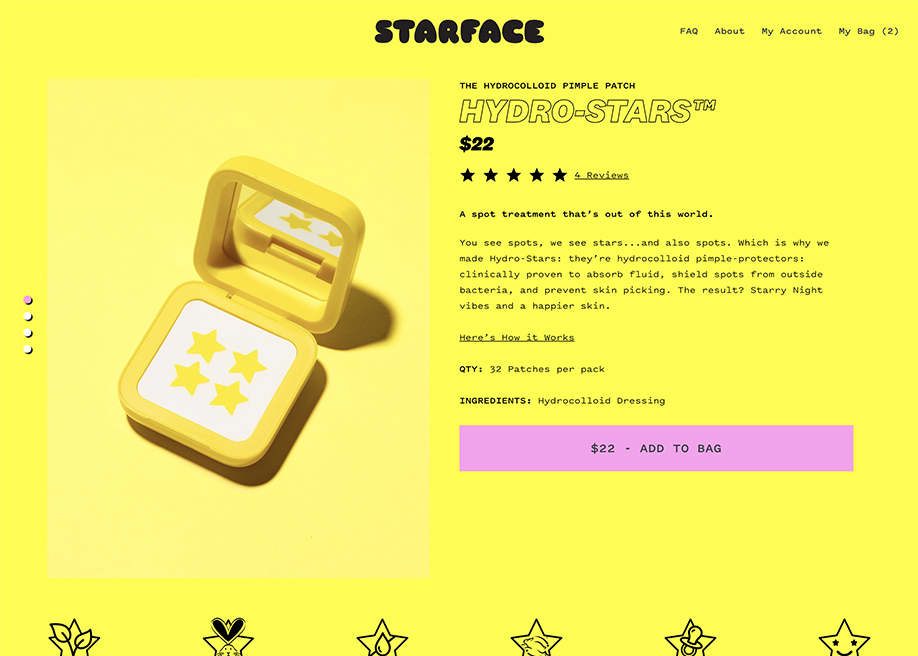
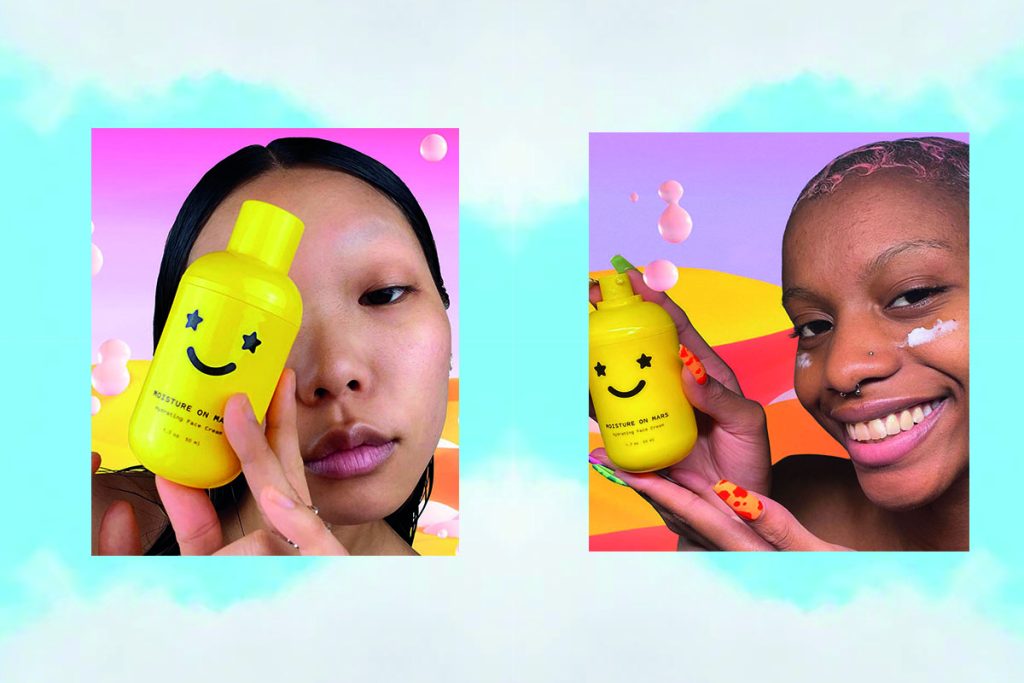
Coffee for a new generation

Created by YouTube sensation Emma Chamberlain, Chamberlain Coffee’s branding perfectly captures the creator’s personality, it’s laidback, fun, and colourful. Interestingly, Chamberlain coffee represents something more than just the coffee; it’s a lifestyle, an attitude.
The brand uses four cute brand characters that relate to Emma’s characteristics such as the Early Bird, the Night Owl, the Careless Cat, and the Social Dog. The website and other brand touchpoints don’t feel overly ‘salesy’ at all. Instead, they use playful and surprising animation prompts to keep buyers engaged.
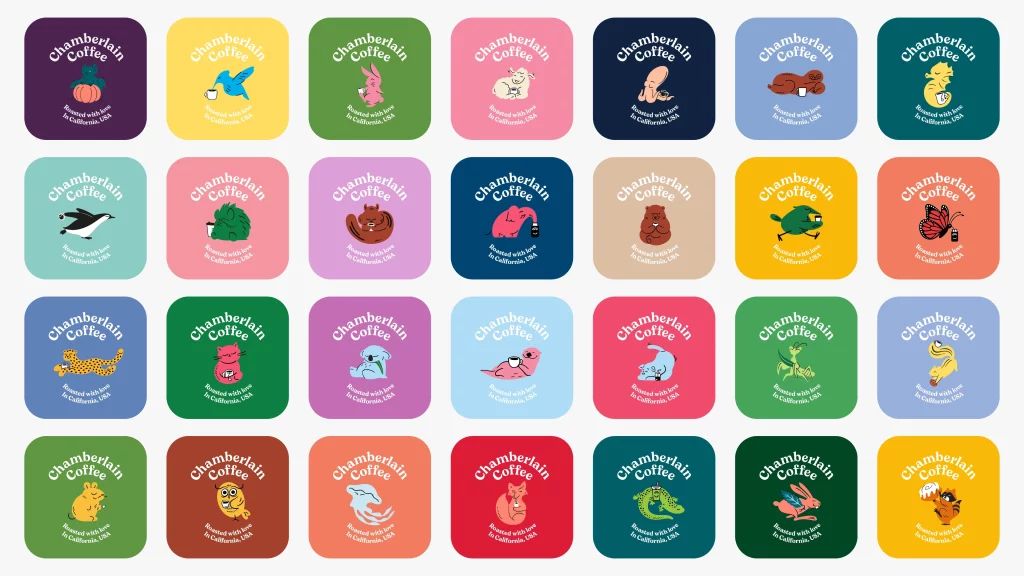

So, there you have it, five brands that are setting the standard when it comes to targeting this much sought-after young target.
From making their mark on dusty and traditional categories to putting the more is more back into branding after years of stripping back often all of the personality from brands.
Get in touch if you want to know more about how we can help you raise the standard of your brand or when it comes to reaching your target audience.
We’re BGN, a brand-led design and creative agency and we help ambitious brands set the standard in their space.
The Benefits of a Responsive Website Design
What do you do if a website takes ages to load or looks odd on your smartphone?
The average consumer clicks away in less than a couple of seconds if a website doesn’t render well on the device they’re using. Seems hasty, but in reality, people are busy and they’ll go elsewhere if the user experience is terrible.
So, if this is your website, you’ve just said goodbye to several customers. Not only that, but search engines also favour responsive web design. If it’s underperforming, you could be sinking down the rankings too.
Websites should work as expected across all devices. Plus, with mobile web traffic making up over half of traffic globally, responsive web design is a must for all businesses.
Let’s take a look at some of the benefits of optimising your site.
Mobile-first search rankings
Search engines are moving into the ‘mobile-first’ realm. This means algorithms rank based on responsiveness and good user experience (among other factors).
To move up the ranks, a website should be optimised for mobile traffic. Plus, work seamlessly across other devices such as tablets, laptops and desktop computers.
Improved user experience
Customers want to shop from a smartphone or desktop in the same way. Responsive web design brings speed, ease of navigation and good user experience to all devices.
An improved user experience also encourages customer loyalty and boosts conversions.
Lower bounce rate
Bounce rate is an important metric to monitor. High bounce rates can indicate numerous things, including poor customer experience.
You may have the exact products everyone wants or great content. However, people will click away if your website is hard to navigate.
Responsive website design can help lower bounce rates with optimised design and functionality.
Faster website loading times
Page speed can make or break the online shopping experience. If your website struggles to load, customers are unlikely to wait. And they might not return.
Using responsive design on your website provides faster loading speeds. In addition, improving page speed is a positive ranking factor in search engines which can also boost where you appear in results.
Easy to manage
Gone are the days of needing a main website and a separate mobile version. Instead, responsive websites are developed and optimised across all devices, saving time when managing and maintaining the site.
Consolidated reporting
One website makes reporting simpler as everything is in one place. You can use analytics tools to identify traffic from different devices.
Information is also available on conversion paths and user journeys to help you further track and optimise the user experience.
Do you have a responsive website?
Curious about how responsive web design could benefit your business? At BGN, our designers are experts in crafting creative and optimised websites that influence your customers.
As a leading website design agency in Manchester, we are also on hand to guide you on branding and campaigns that stand out in the market. Contact us to get started.
Best Creative Website Design Tips For An Ecommerce Site
Online shopping experiences should be simple and straightforward. Unfortunately, we’ve all had bad ones in the past.
You know the scenario – search for a product, click through the options on Google. Then face a website bombarding you with messy content, disorganised menus and product pictures that look amateur at best.
Like all websites, aesthetics are an important part of keeping customers hooked while they browse. And to get those conversions, you need to delve even deeper to ensure you create a hassle-free checkout process.
Read on to learn more about blending creativity with user-friendly website design.
Keep the design simple
Simple and creative often feel like they don’t fit together. But in reality, simple aesthetics offer room for focal features on your website. The main aspects should allow a straightforward user experience. However, two key areas can bring the design to life – colours and typography.
Brand colours
Colour has a surprising effect on emotions and responses. But, that’s not always positive. Too many colours and it’s overwhelming. Try to stick to five or less in your branding and choose shades that complement each other for a positive interaction.
Typography
Of course, if you want people to read your content, it needs to be legible. Consider the typeface style, as this is how customers interpret your brand. Plus, don’t go crazy with lots of different fonts. Try to stick to three or fewer to ensure consistency.
Use high-quality images and videos
Good quality images always boost conversions. Customers want to see the details of what they’re buying.
To enhance the experience further, incorporate video or 360-degree imagery. Think about the background and aesthetics for your shots. Product photos should be clear and detailed.
Use original design features
There are tons of templates and stock graphics out there. However, a little originality goes a long way. Hire a designer to create brand icons, illustrations and graphics to enhance the visual interpretation of your brand and website.
Utilise the latest web design trends
Every industry recognises trends and the web design world is no different. While not every trend is suitable for every business, some are often easily incorporated.
For example, creative website design trends in 2022 include:
- Oversized typography
- Interactive fonts
- Collage visuals and graphics
- Black outlines and bordered buttons
- Gender-neutral design
Make navigation a focal feature
A website menu is often stuffed in the top or sidebar, and while customers subconsciously know this, why not make finding products even easier? Make navigation more visual, up front and centre.
For example, check out websites such as Etsy and Not On The High Street. You’ll find navigational visuals that take you straight to what you want. Plus, you can switch these up to improve sales in specific product categories or to focus on trending items.
Creative website design ideas that convert
Are you looking to improve your website with exciting and visually creative elements that boost conversions? We can help! Our website design agency in Manchester is on hand to help your business take the next step in ecommerce marketing. Contact us today to find out more.
Top Tips to Gain Customer Insight
Customer insights will give you valuable information on your audience’s behaviours and preferences. By staying in touch with target buyers, you can anticipate and serve their needs, increasing the likelihood of conversion and repurchase. Not sure where to start? Learn how to gain customer insight to boost your brand’s success below.
How to gain customer insight
Ask for customer feedback and input
If you’ve already got a loyal consumer base, put this to good use. Ask your customers for their feedback via tools such as customer sentiment surveys, interviews, reviews or questionnaires. Use the insight gained to develop new product/ service offerings and to inform future marketing campaigns.
This also gives you the chance to learn from any negative feedback, so that you’re constantly adapting and improving as a brand.
Learn from competitors
Competitors are just as likely to make use of the above tools as you are. Where survey results and industry reports are made available to the public, you can learn all about your competitors’ strengths and weaknesses in relation to your own company.
Look out for gaps that you feel your organisation can fill and gauge how you can adapt to serve any needs expressed by consumers. By matching your offerings to those missing from other companies, you’re differentiating your brand from others and ensuring that you’re in a unique position to serve customers’ needs.
Use available tools and tech
Your company may already have digital marketing tools like Klaviyo or Mailchimp. In this case, you’ll have access to a wealth of information on customer behaviour and habits. Use the data provided by these tools to segment your audience into more tailored groups and promote products and/or services that they want and need.
You can also use tools like Google Analytics and social media analytics in order to gain behavioural, demographic and campaign data and insights. Learn from any projects that are performing poorly and adapt accordingly using existing information on customer behaviour.
Perform real-time user testing with A/B tests and see how your consumer base reacts to different elements. For instance, you can try different social post formats, copy and images to see which proves the most popular in terms of engagement. You can then use this customer insight to inform future company decisions and practices.
Keep on top of market research
Market research will typically be conducted by third parties. It can provide valuable insight, delivering key statistics alongside knowledge into customers and markets. If you’re a small brand looking to grow, you may not yet have access to sophisticated tools or a large audience from which to gain valuable customer insights.
Being aware of trends within your industry is therefore critical, as it will help you stay relevant and enable you to identify market gaps that you can use to your advantage.
Get in touch with your audience
At BGN, we pride ourselves on ranking amongst the top brand consultants in Manchester. By aligning your messaging strategy, visual designs and multichannel communications with target buyer needs, we can help your brand make its mark.
Discover how we can help you gain customer insight to take your business to the next level by contacting us today.
How to Define Brand Tonality for Your Business
Brand tonality can make or break your company. That might sound like an overstatement, however, being able to hook consumers in with a relatable and memorable first impression is critical.
With that in mind, we’ve put together some top tips and tricks to help you define your brand tonality and stand out – even in today’s oversaturated market.
How to establish your brand’s tonality
Brand tonality is not really about what a brand is saying, but how they say it. The character, personality and quality of voice is what distinguishes one brand’s tonality from the rest. So, how should you establish brand tonality?
Identify your own mission statement
Your brand’s tonality needs to reflect your brand’s personality and values. One of the best ways to do so is with a mission statement. This should be concise but clear, as it will shape the culture of your brand and lets potential customers know who you are.
Your mission statement essentially communicates what you’re all about and why you’re business is relevant to them. It also informs your brand’s tonality – for example, you may not want to come across as too technical or serious, but still want to impart specialist knowledge. Only you know what these ‘dos and don’ts’ are, and it’s useful to distinguish them from the off for a consistent tone across all channels.
Drill down into your audience’s needs
You need to get to know your audience. Use data from analytic tools to drill down into their needs, wants and behaviours. This will give you greater insight into what demographic you’re speaking to, which will inform exactly how you speak to them.
Maybe you already have a particular customer in mind – this is often called a buyer persona. Who is this person, what kind of content do they consume and how do they prefer to be communicated to? Brainstorm answers to these questions and you’ll start to identify a suitable brand tonality.
Research and replicate your successes
Your brand may well have already produced consumer-facing work. If you have content that’s attracted audiences, it’s worth noting any consistencies. Maybe you use humour to engage people or perhaps it’s specialist knowledge that’s attracted dedicated audiences.
This isn’t to say that you should stick to tired old formats – in fact, your brand’s tonality should be adaptable over time. But you should use insights gained from successful work in order to inform your brand communications moving forward.
Need help with your brand tonality?
As a specialist branding agency in Manchester, BGN are here to help you maximise your brand’s potential. Our talented team will help you find your brand’s tonality by concentrating on the stories that you want to tell – the what, the why and the how.
We care about your success just as much as you do, so why not contact us today to see how we can help?
Exploring The Importance of Graphic Design in Branding
We all know that old saying – a picture is worth a thousand words. These words ring particularly true when it comes to branding. After all, quality graphic design is an integral part of any successful company.
Think of some of the most successful businesses in the world, from Apple and Barclays to KFC or McDonald’s. What do they all have in common? That they boast immediately recognisable aesthetics that work as placeholders for the products themselves.
The importance of graphic design in branding cannot be overstated. In order to drive the point home, below we’ll break down three reasons why graphic design is a crucial factor in any good branding strategy.
Why graphic design is so important for branding…
1. First impressions
Even if we pretend that they don’t, the truth is that first impressions matter. A customer’s first interaction with your brand is likely to stay with them for the rest of your business relationship. More often than not, that first interaction is purely visual. A customer might be so intrigued by a brand’s logo or website that they immediately decide to check out their products.
Suffice to say, this also works the opposite way. Poor graphic design will inevitably drive your customers away. Would you trust a business with a logo that features a pixelated, generic stock photo? Probably not. Similarly, a slogan using WordArt as a font would likely make your company a laughingstock.
2. Too long; didn’t read
In Internet slang, “TL;DR” stands for “too long; didn’t read”. It’s basically a way of saying that a piece of text is not worth your time. Memes aside, the popularity of this acronym speaks volumes about our tendency to favour snappy visual cues over elaborate text.
In the end, humans are visual creatures – so much so that our brains process images a lot faster than words. In fact, according to a study by MIT, the speed at which we identify images is up to 600 times faster than with written text. That means that how you display the things you say is even more important than the things you say.
3. Create your own visual identity
Brands need faces. Not literal faces, but images and personalities that help to create that special connection with your customers. In marketing, we refer to that collection of visual elements as visual identity.
For example, Apple uses metallic and minimalistic fonts and designs to convey innovation, straightforwardness and quality. It’s best practice to use a style guide with primary colour palettes and type designs that reflect your company’s values. Over time, this will help you create a recognisable visual identity that will foster strong emotional responses amongst your target audience.
Start building a unique narrative today
Every business has a story to tell. What really sets successful businesses apart from unsuccessful ones is how they tell it. At BGN, our brand consultants in Manchester understand the importance of graphic design in branding and they can help you to stand out from the herd by creating graphics that convey your company’s message.
Sound good? Give us a shout to find out about what we can do to build up a refined brand design from scratch.
What Is The Importance of Integrated Brand Communication?
In today’s over-saturated and fast-evolving marketing environment, it can be easy to lose track of the big picture. As a result, the marketing efforts of too many businesses end up being little more than shots in the dark.
This directionless approach might work for a while, but it’s bound to let you down in the long term. Trying to build a brand without an integrated communications plan is like trying to win Wimbledon without a tennis racket. Fortunately, there’s an easy way of avoiding this – implementing a strategy based on what we call IBC (Integrated Brand Communication).
In a nutshell, IBC is an all-encompassing strategy that considers all communications activities within the larger context of a company’s brand. Instead of every department being its own little island, IBC encourages integrated communications efforts that have a company’s brand at their core. This means that each team works together with a clear objective in mind. And that objective is to build solid relationships with clients and customers while reinforcing the company’s brand values.
Read on as we outline three key benefits of Integrated Brand Communication for every kind of business.
Advantages of integrated brand communication
1. Improved recognition and trust
There’s no surprise with this one. The only thing that will make your brand stand out from the crowd is its uniqueness. By implementing a uniform way of communicating in every department from Sales to Customer Service, your customers will be able to tell you apart from rival companies. On top of that, you’ll build a higher degree of trust with your target audience as a clear brand voice fosters familiarity. Combined with consistent communication, this is the most effective way to build brand recognition.
2. Clarity
In marketing, avoiding confusion goes a long way. A single, to-the-point message will always be much more effective than lots of different messages. By streamlining your communication efforts, Integrated Brand Communication will bring a sense of coherence to your company. Every message that your brand sends will reinforce and support each other, significantly strengthening your company’s image in the process.
It’s worth clarifying that implementing an IBC strategy does not limit the creation of segmented campaigns for different audiences. Contrary to what sceptics might think, Integrated Brand Communication is not about putting all your eggs in one basket. Instead, every campaign will take the customer back to your company’s core values.
3. Create your own corporate culture
On top of reinforcing relations with your customers, IBC strategies also strengthen the bond between your company and your employees. According to a recent study, 46% of job seekers think that corporate culture is a decisive factor when applying for jobs. By instilling your brand values into your employees, you will provide them with a clear picture of what their role is, where they fit and any opportunities open to them. This is a great way to keep your workforce happy and reduce employee turnover.
Make meaningful connections
As we’ve shown, Integrated Brand Communication can be the key that unlocks your company’s true potential. If you want to build a solid, all-encompassing communications strategy, get in touch with us today.
Our brand communications agency in Manchester will work in partnership with you to develop a unique voice for your business.
An Introduction to the Main Elements of Brand Design
Brand design is one of the most important parts of the branding process. Let’s start by defining it. Simply put, brand design is the process of creating a brand’s identity. If you think that sounds easy, think again. All the elements of brand design have to play off each other to convey a unified statement. The twist is that you’re competing against many other companies, all working towards the same goal – to pique a customer’s interest. Designing your brand is your big chance to explain to potential customers why your products and services are better than your competitors’.
In order to attract potential customers, your brand design needs to tell your company’s story in a concise and captivating way. With competition between businesses sharper than ever and attention spans shrinking by the second, it’s never been harder to stand out from the rest. That’s why breaking down brand design to its elementary components is so helpful. By adjusting every aspect of your brand design to your USPs, making that big statement will be a lot easier.
Read on as we walk you through the main elements of brand design.
Slogan
The history of branding is full of catchy slogans that have left their mark on public consciousness. “Just do it”; “I’m lovin’ it”. “Eat fresh”. Unless you’ve spent your entire life living under a rock, chances are that you’ll know who all these phrases belong to. That’s because the best slogans work as stand-ins for their brands.
A slogan is much more than a memorable phrase that persuades potential customers to buy a product. It’s a way of defining your brand and showing its personality to the world. It’s not unlike trying to paint a Van Gogh on the world’s smallest canvas. Your slogan needs to encapsulate the uniqueness of your brand in just a few words whilst making a lasting impact on your target audience.
Logo
Think about going to the supermarket to buy groceries. You’ve done it so many times that it has almost become an unconscious process. You walk through the aisles on autopilot, filling your basket with tea, muesli and baked beans. But if you stop and think, you’ll notice that you tend to go for products with logos you immediately recognise. This is because they evoke a sense of familiarity and because you associate them with good quality. You might even try a company’s new product because you know what they stand for. That is the level of trust that a good logo can build up over the years.
Not even the world’s best slogan could attract customers without a great logo. Arranging images, symbols and words to express the essence and purpose of your company is a crucial part of brand design.
Typography and colour scheme
These two concepts involve the colours and fonts you use in your designs and products. Just like a slogan is nothing without a logo, a logo can’t grab a customer’s attention without a recognisable typography and colour scheme. If a particular colour is known to represent your brand and its values, you’re doing something right.
Think of Starbucks’s use of green and a stately, no-frills font in white. It evokes healthy, eco-friendly products for busy professionals in desperate need of a caffeine rush. Colour and typography therefore help build brand recognition and instil a sense of professionalism that will make your business seem more credible and trustworthy.
Design your brand with care
Want to nail your brand design but aren’t sure where to start? At BGN, our brand consultants in Manchester will carefully review your business and come up with a brand design that encapsulates your mission statement and values. Get in touch with us today to learn more about how we can help you create a standout brand strategy.
Top Methods to Analyse Your Industry Insight
More often than not, the difference between a successful business and an unsuccessful one is that the latter got its numbers wrong. That’s even truer in the current digital landscape in which we operate. We live in a fast-changing world where trends appear and disappear in just a matter of days. Blink and you might just be left behind!
There is only one way for businesses to cope with constantly fluid trends and ferocious competition – and that is industry insight. By accessing real-time data on consumers and identifying market trends, you’ll be able to tweak your products and services to cater to the needs of your target audience.
Let’s take a look at how to do it.
Focus groups
A focus group is a research technique where data is gathered after observing a group’s interaction with a certain product or idea. Focus groups can shed light on how your target audience thinks and, most importantly, what they want from your business. But remember, this isn’t some friends getting together and talking over each other. To get the right answers, you’ll need to ask the right questions.
Usually, a focus group will be presented with a new product and asked what they like and what they don’t about it. This will give you a clear insight of what you’re doing well and what you need to improve. There is only one caveat. Sometimes, participants with more imposing personalities will take over the discussion and effectively dictate what the group thinks. To stop peer pressure from contaminating data, it is recommended to make individual, anonymous polls before the group discussion takes place. That way, everyone’s thoughts will be accurately reflected.
Trend analysis
Relying solely on focus groups can lead to inaccurate data purely due to small sample size limitations. You need to look at the bigger picture, and there’s only one way to do it – data.
By accessing customer data, you will be able to identify customer trends and adapt your business to improve its chances of success. It will also give you a clearer idea of the demographics of your target audience. This will help you define which groups of people you should target, making your marketing more focused and cost-effective.
Forecasting
A crucial aspect of building a successful business is to figure out what future trends will be. If you think of some of the biggest companies in the world, you’ll notice a certain pattern. From Apple to McDonald’s, all of them were ahead of the curve at one point when it came to identifying market trends.
Forecasting is the process of guessing future trends by looking at past and current data. However, this isn’t a matter of luck. It’s all about playing the numbers game – and playing it right. If you want your industry insight to give you an edge over your competitors, you’ll need to rely on genuine data collated by experts.
Be ahead of the curve with your industry insight
With our strategic approach to industry insight, you’ll never be left in the dark. We’ll start off by digging deep into your company culture and outlining your values and personality. Then, our industry insight experts in Manchester will use your customer data to create a roadmap that takes you through the necessary steps to help your business grow. If you want to cruise past your competitors, give us a shout today and we’ll figure it out together.
The Most Common Barriers to Business Growth
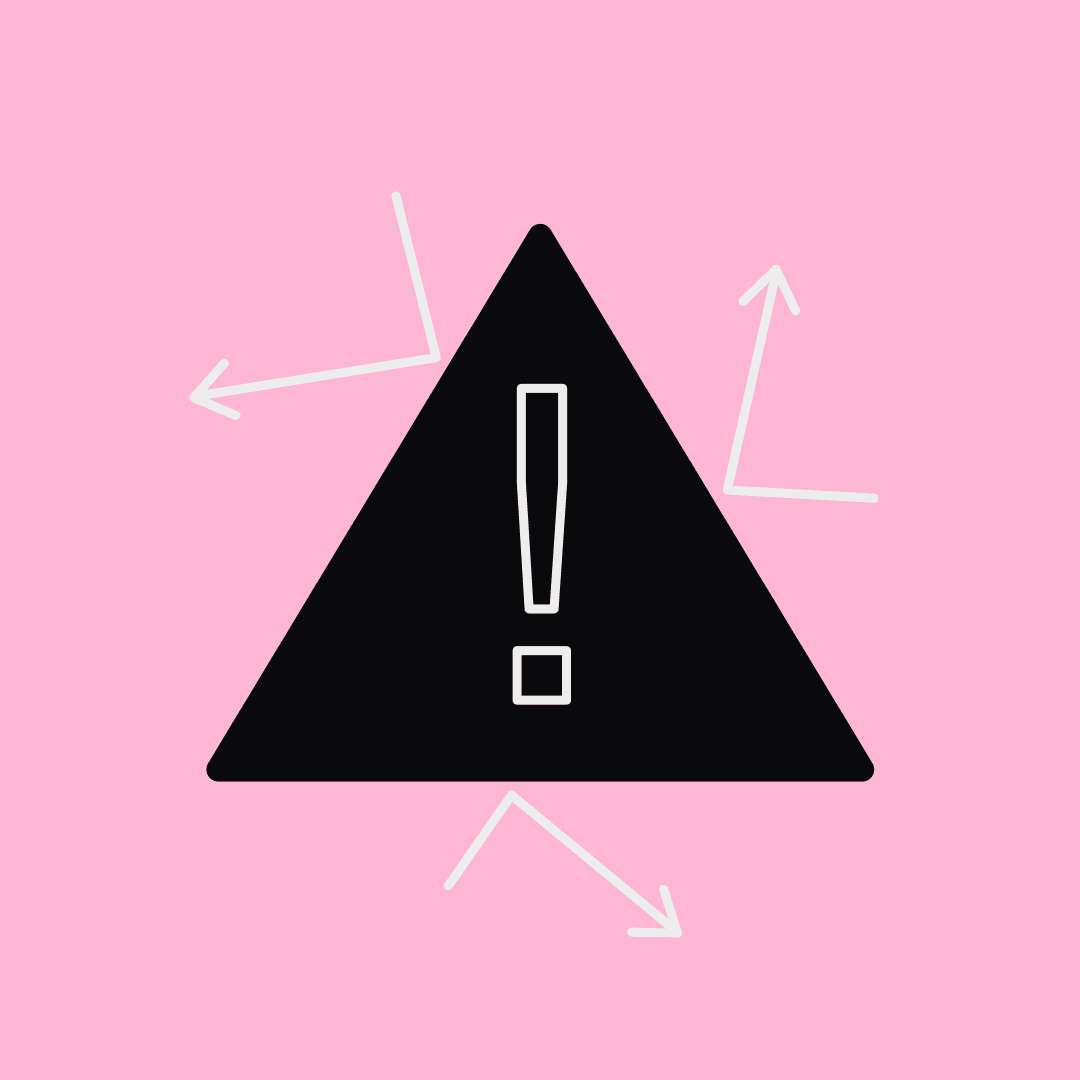
From pet food and artisan cheese to small-batch whiskey and salon-inspired hair products, the best brands know how to break down barriers to business growth. There’s no one-size fits all approach when it comes to growing your business, but it is worth familiarising yourself with problem areas where lots of enterprises slip up.
Ready to get stuck in? Read on to find out more about how to not just overcome, but completely obliterate four common barriers to business growth.
1. Not leveraging social media
Love it or hate it, social media is one of the most powerful business growth tools out there. If your brand isn’t leveraging digital platforms like Facebook and Instagram, you’re missing out on huge growth opportunities. Start by ramping up your online presence and posting on a regular basis – weekly at an absolute minimum. When you’ve found your rhythm, you can advance to strategies like paid advertising and partnerships with influencers. Social media can be a difficult realm to navigate and more often than not, it’s worth investing in help from the experts. This leaves you free to focus on other business growth strategies.
2. Lack of strategic planning
While some start-ups wax lyrical about overnight success, the truth is that it takes time, effort and a clear-cut strategy to build a brand with staying power. This means you’ll need to invest time into detailing your brand goals and planning how you’re going to achieve them. It’s also worth exploring the values that underpin your brand and why they matter, as this will feed into the marketing materials you create to advertise your business and its offerings.
3. Failing to draft a mission statement
A powerful mission statement is one of the best ways to smash barriers to business growth. Short and sweet, your mission statement is a summary of your brand vision and can be used to engage both employees and customers. If you’re ever unsure of how to move forward with your business growth strategy, you can then pivot back to your mission statement for guidance.
4. Disengaged employees
Whether you run a bricks-and-mortar store, a door-to-door service or a digital empire, employees are the bread and butter of your business. They are the people who engage with your customers daily and have a huge amount of power when it comes to driving business growth.
With the latest statistics revealing that only 50% of British employees feel engaged and “enthusiastic” about their jobs, chances are there’s room for improvement. Actively listening to employees, recognising and rewarding achievements and offering career development opportunities are just some of the ways top-performing businesses improve engagement ahead of growth.
Grow your business with BGN
With so many growth opportunities out there, there’s no reason for your business to fall short. Get in touch with the BGN team today to discuss how our tailored brand strategy service can help to grow your business from the ground up. With a dedicated team of experts on your side, you can break down the barriers to business growth and take your organisation to new heights.
Initial Stepping Stones in Creating a Vision for Your Business

If you’re starting a new company or going through a rebrand, it’s crucial that you create a clear vision for your business. Put simply, a business vision summarises what you want your business to achieve or become in the future.
It usually takes the form of a vision statement, which outlines a company’s ultimate destination and gives employees direction. A clear business vision will also aid the strategic planning process and help you make decisions with an aim in mind. Keep reading to find out more…
How to create a business vision
Research competitors
When developing your business vision, competitor analysis is a good place to start. Visit the websites of companies you admire and direct competitors to read about their vision and values. How do they present themselves? How are they perceived by others? What is their purpose and what problems do they solve? What are their strengths? Then answer similar foundational questions about your own business.
Brainstorm core values and keywords
Next, consider your core company values. These are what you stand for as a brand and act as guiding principles for employees. You should also come up with a list of keywords relating to your product, mission and goals, that you could use in your vision statement. A brainstorming session with stakeholders and those responsible for implementation is a great way to gather ideas and ensure everyone is on the same page.
Think long-term and dream big
While your business vision needs to be realistically attainable, it can still be bold. After all, this is the overriding goal for your business and the ideal scenario you’re aspiring for if all goes well. Think about where you’d like it to be in 5 or even 10 years’ time. What impact would you like your business to have on your customers, community and industry in the long term? Remember to align your ideas with the core values discussed above.
Draft your vision statement and ask for feedback
It’s now time to draft your vision statement. Start by getting some rough notes down on paper – you can refine them later. Answer important foundational questions about your core purpose and values, add in keywords and be concise. Aim for a paragraph at first and then condense it down into one or two sentences of no more than 35 words. As an example, this is Google’s: “To provide access to the world’s information in one click.”
Finally, get feedback from your colleagues and industry peers to check the statement resonates and that it is easy to understand before sharing it with the entire team.
Need help refining your business vision?
Before you come up with any marketing plans or strategies, you’ll need to define your company’s ultimate goal. If you’re struggling with creating a vision for your business, our Manchester-based brand strategists can help you turn your ideas into a tangible vision statement. Simply email us at info@bgn.agency and we’ll be in touch.
6 Simple Things You Can Do to Increase Brand Identity
Your brand identity is what differentiates you from the competition. It consists of a distinctive set of elements like logos, typography, colours, packaging and messaging that communicate your company’s mission and values to potential customers.
It’s hard to overstate the importance of a strong brand identity. It tells people what you’re all about and ensures that your business is easily recognisable, no matter where your products or content pops up. Over time, this familiarity builds trust and credibility to ultimately increase your profits.
So how do you increase awareness of your brand identity? Read on to find out…
6 ways to increase your brand identity
Create a memorable logo and a catchy tagline
Your logo should represent what your company does and what you stand for. Keep it simple using your brand colours, a distinct graphic and a clear font that is scalable.
Catchy taglines are also great for brand recognition, as they stick in people’s minds. They can be tricky to create as you only have a few words to work with, but they are highly effective – think “Every Little Helps” by Tesco.
Engage on social
While you don’t have to be on every social media platform, you should be on the most relevant ones for your company and target audience.
It’s also vital that you don’t just post content without engaging with your followers. Include clear CTAs in your captions, use polls to ask questions and reply to comments. That way, you’ll develop a relationship and appear in their notifications.
Share your story
Your brand is more than just a logo. Sharing the story behind your brand will set you apart from your competitors and create connections with people who can relate to your purpose and aims.
Be authentic and show some personality. Highlight struggles as well as successes, and explain why you feel what you offer is important and benefits for the end user.
Provide value on a regular basis
One of your best promotional tools is email marketing. After all, it’s much easier to sell to existing customers and warm leads than new clients.
As well as promoting your offering, provide value in your mailshots with links to useful blog posts and provide exclusive discounts to reward loyalty and aid satisfaction. Make sure emails are responsive on mobile devices and stick to a regular schedule for better open rates.
Be consistent
Visual consistency helps to build brand recognition and trust. Although your print material may differ from your online assets in terms of format and the copy you include, the colours, theme, fonts and messaging should remain consistent.
Creating a clear set of brand guidelines for designers to refer to, is a great way to ensure a cohesive look and feel throughout your marketing.
Monitor and adapt
Lastly, you should regularly assess and refine your brand identity to remain competitive in the marketplace. Survey your customers to see how they feel about your brand and identify the message you’re giving out – if it’s not what you were aiming for, make some changes to meet your goals.
You should also monitor social media comments and reviews to see what people are saying about your brand, and track the demographics of those who are engaging with you and buying your products, to make sure you’re reaching your target audience.
Need help with your brand identity?
Strengthening your brand identity is no mean feat. Thankfully, the team at BGN have a wealth of experience building brand identities for clients of all shapes and sizes. Contact our dedicated branding agency in Manchester today and we will guide you through the process step by step.
A Guide to Making Creative Mood Boards That Will Inspire People

When it comes to building a unique brand identity, it can be difficult to communicate your initial ideas in a way that others can envisage. Mood boards are a great way to organise your ideas visually, creating a reference to aid brand development.
Not sure where to start? Explore our guide to making creative mood boards that will inspire people below.
What is a mood board and why do I need one?
A mood board is a collage of visual elements that represent your brand identity. Elements can include images, text, fabrics, colour swatches and patterns. When combined, they give the viewer a feel for what your brand is all about.
Creative mood boards enable you to share your vision and the attributes you want to convey in a tangible way. They’re often used as a starting point for inspiration when designing websites, marketing assets and graphics for advertising.
Physical vs digital
Mood boards are traditionally physical collages, made by piecing together magazine clippings, fabrics and photos on a foam board. Nowadays, many people opt for a digital mood board with interactive elements such as audio or video clips instead. Though not as tactile, they are more accessible for remote teams.
How to make a mood board – things to include
Images
These may be brand photos, illustrations, stock images or your own photos. If something inspires you. take a photo on your phone and note down your thoughts and feelings to refer back to.
It’s good practice to make several key images the focal point and build ideas around them, to highlight the most important aspects and create a clear theme for the board.
Colours
Colours are a vital part of branding, so the ones you use in your creative mood board should reflect your messaging. Consider the kind of vibe you want to create and what colours would appeal to your target audience. Do they prefer bold or muted colours? Warm shades are more fun, cool tones are more professional. Choose up to five.
Patterns & textures
Just like colours, patterns and textures (in physical mood boards) also provide insight into the style you’re going for. For example, you may prefer subtle stripes over loud floral patterns, or luxury silk over simple cotton.
Video & audio
From GIFs to YouTube clips, adding interactive elements to a digital mood board can really help to bring your vision to life and give others a sense of what you’re going for.
Text
Carefully chosen words, inspirational quotes and labels explaining your thought process can strengthen the messaging behind your visual elements. You should also consider the fonts you use to display text, as each one has a different connotation.
Refine your brand identity
A mood board is the first step to creating your brand identity. It conveys the essence of your business and creates a springboard for other creative projects.
At BGN, our team of Manchester-based brand consultants will work with you to build your brand identity from the ground up using visual assets that inspire you.
We’ll then use these initial ideas to bring your vision to life, developing clear branding for use throughout your website and marketing materials. Get in touch today to get started.
An Introduction to Building Your Brand on Social Media
Having an up-to-date social media presence is a must nowadays. It shows that your brand is moving with the times and that you’re interested in meeting your customers where they are online. Plus, as a method of two-way communication, social media branding can help to build trust and loyalty.
Want to learn more about building your brand on social media? Read on as we cover several key things to consider when you’re starting out.
How to build your brand on social media
Define your audience and choose platforms accordingly
When it comes to building your brand on social media, remember that you don’t have to be on every platform. In fact, each one has a different audience and you should be focusing on where your potential customers are.
For example, LinkedIn is aimed at business professionals, the majority of Instagram users are under 35 and Facebook is the largest social platform with over 2.85 billion global monthly users. As a result, most brands have a Facebook page at a minimum.
Creating buyer personas based on the demographics of your online customer base will help you choose the right platforms and align your content with your target buyer.
Ensure your branding is consistent
Regardless of how many platforms you’re on, your social media branding needs to be consistent. The colours, fonts and messaging you use on social should also tie in with your website design and offline marketing materials.
As well as creating a professional appearance, cohesive branding makes it easier for people to recognise your brand wherever they come across your content online. Over time, this brand recognition helps to build customer loyalty.
To stay consistent, use your brand logo as your profile picture and make sure your company values are clear throughout your social bios and captions.
Plan what content you’re going to post
When building your brand on social media, you should provide a mix of content that is helpful, shareable and aligned with your business goals. Your posts should also be adapted to suit each platform’s unique features, such as Instagram stories and reels.
Video content is doing particularly well on social at the moment. According to Wyzowl, over 84% of people have been convinced to buy a product or service by watching a brand video, so you should definitely incorporate video into your plan.
You can create a simple content plan for your posts using a spreadsheet. List the platform, topic, format, copy and media for each post per week. Then, schedule your posts in advance using an online tool such as Later or Sendible to stay on top of posting. We’d also advise leaving room for topical posts as new trends arise.
Get social
Finally, remember to interact and engage with your audience. Responding to as many comments, questions and messages is good customer service and shows that you care about your customers. You should also listen to feedback and use polls for market research to ensure your content is meeting your audience’s needs.
Need help getting started? At BGN, our social media branding experts in Manchester can help you set up new profiles or audit existing ones. Short on time? We can even plan your strategy and manage campaigns for you. Contact us today to learn more.
New LGH Work & Ancoats Digs
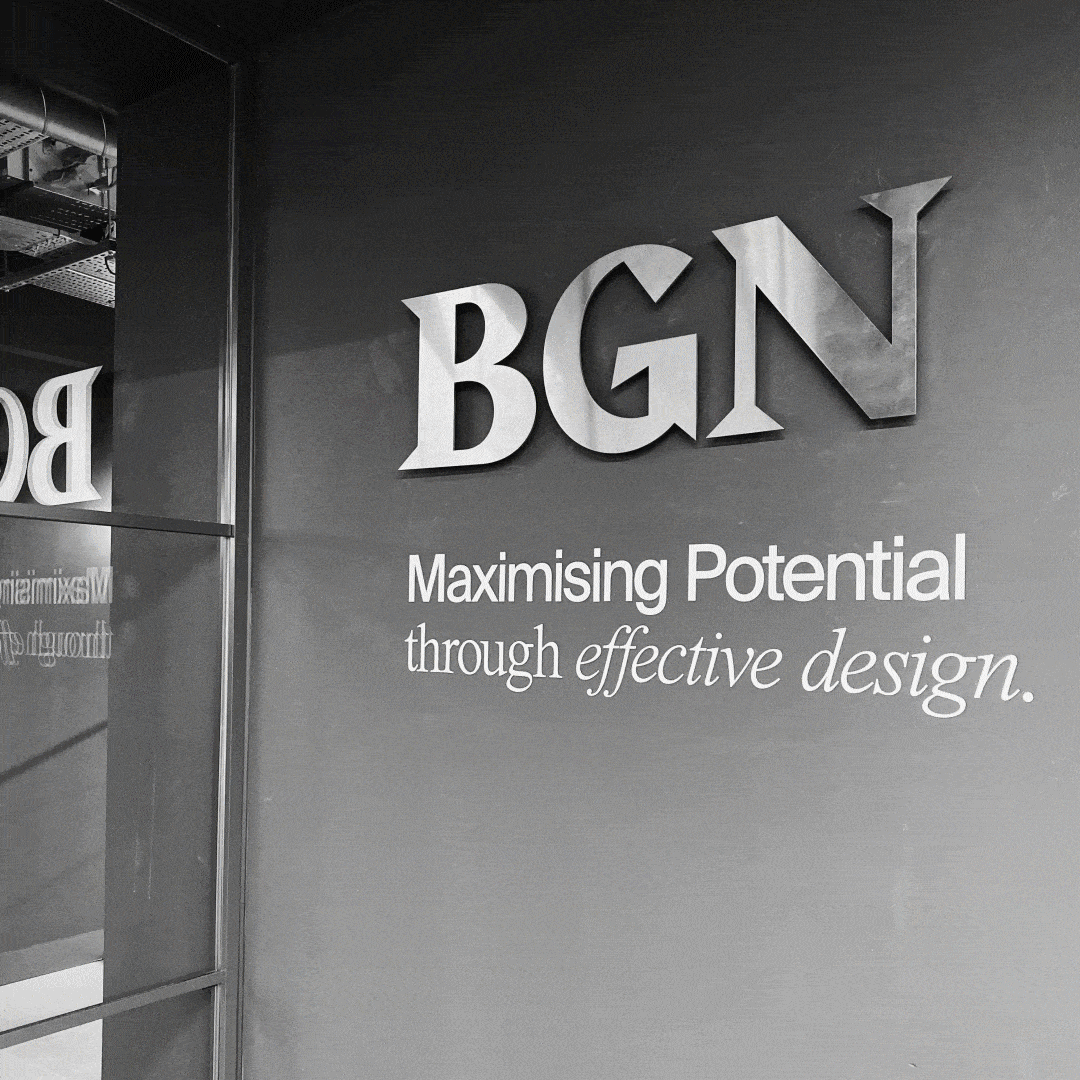
Well here we are, July had marked the “official” COVID restriction freedom. Albeit working from home was fun, the novelty soon wore thin.
Like many businesses, from almost every industry, we’re all slowly filtering back in to the office — which leads us to announce, our brand new design studio is soon to be open!
Based in the former Daily Express Building, we’ll have a fresh new set-up right in the heart of Ancoats, Manchester. We’ll be looking forward to welcoming you in, with a proper brew and a new bunch of faces as we’ve grown the team.
Whilst the agency world has generally been quite lucky and has easily adapted during the pandemic, some others not so much, particularly hospitality.
We were recently briefed by our client LGH Hotel Management to create a video announcing their hotels are now back open and ready for bookings. More than keen to help support and get this industry get back on its feet, our in-house animator designed and created an animation to do just that.
With the aim to boost meetings, events and tour bookings in the LGH hotels, which includes the IHG and Best Western, we showcased their fun and bubbly account management team in a short video for LinkedIn.
Watch the video here
3 Ways to Align Your Brand and Influencers for an Authentic Partnership
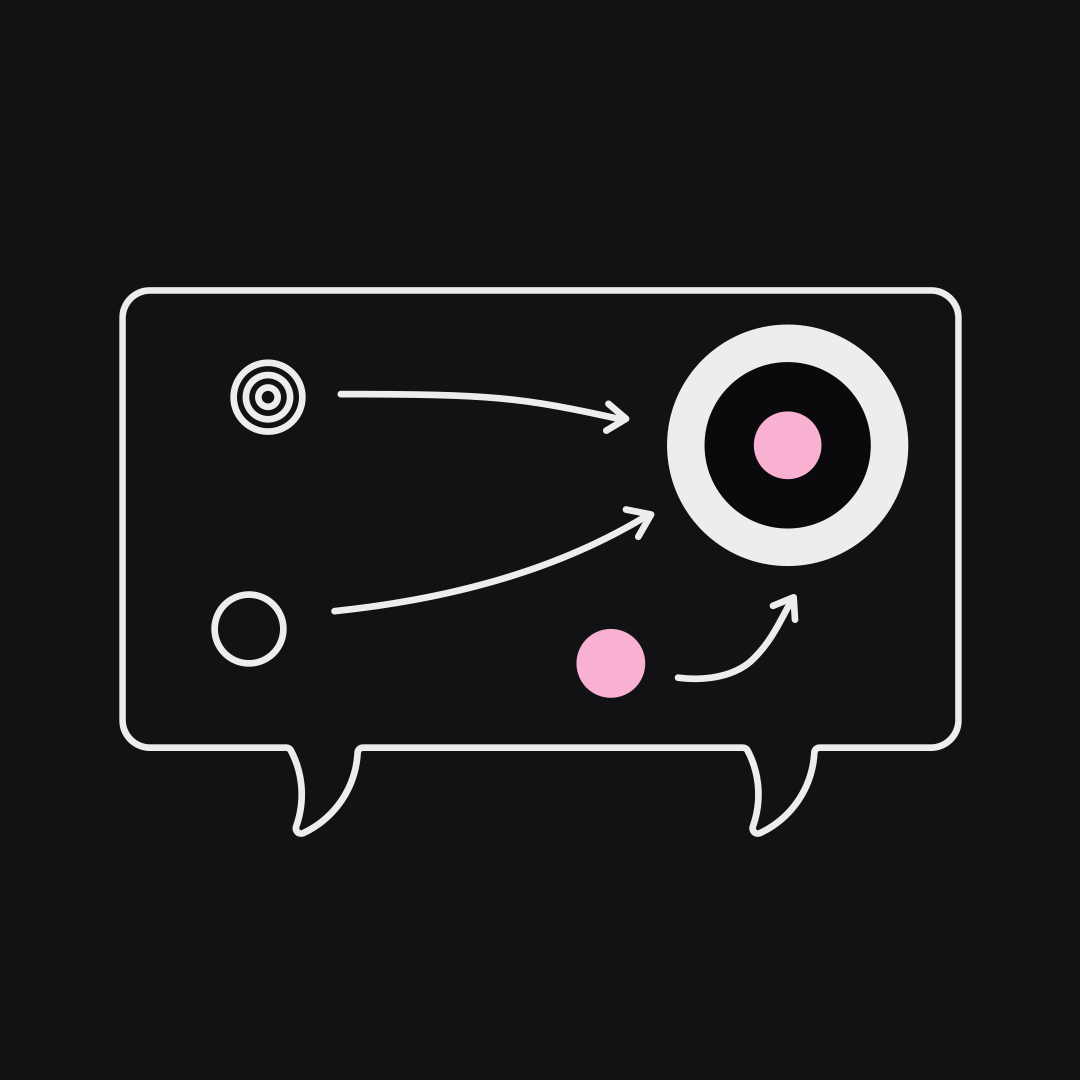
Social media has transformed the way brands connect with customers, and influencers are at the heart of the revolution. Brand and influencers partnerships can be a powerful way to showcase your products and expand your audience, though to unlock genuine results your approach needs to be strategic and most importantly, authentic.
Want to know more? Read on as we highlight three ways to align your brand and influencers for an authentic partnership.
1. Connect and communicate with your influencers
Connecting and communicating with your influencers is one of the best ways to amplify your marketing campaigns. The more an influencer knows about your brand, the better they can align themselves with your unique goals and values. For example, if you’re launching a new ethically made clothing line, it’s not enough to send out samples to influencers and let them do their thing.
As a brand, you need to take the lead and ensure they have everything they need to genuinely connect with followers and showcase your product in the best possible light. This could mean educating them on the origins of the fabric, how it feels and what makes it so amazing for the British weather. You could also ask your influencer to pepper their posts with evocative words you want to use across your campaign. This will help create continuity across your channels and add to the authenticity of your brand and influencers campaigns.
2. Take the time to research your potential influencers
When it comes to building authentic partnerships with influencers, it pays to do your research. Start by selecting influencers who share the same values as your brand. While some influencers are out there to score free products and perks, genuine influencers know the value of working with brands that align with their beliefs.
Another big faux pas is focussing exclusively on imagery and failing to read captions when choosing your brand and influencers partnerships. This sort of tunnel vision can lead to partnerships with influencers who align with your brand on the surface but don’t have any integrity. Taking the time to get to know your pool of influencers before you propose partnerships will help you build meaningful relationships with your brand ambassadors and your customers.
Pro tip: look for quality over quantity when it comes to followers. Some influencers do a pretty good job of racking up a huge number of followers that don’t necessarily offer much in the way of value. When checking out profiles for your brand and influencers partnership, look at what kinds of comments are being left and if the influencer engages with their followers. Why does this matter? Working with influencers who have a genuine and engaged follower base will drastically improve the impact of your campaign.
3. Embrace micro-influencers
While big-ticket influencers like the Kardashians have serious social media sway, smaller brands can unlock incredible value from micro-influencers. Unlike their counterparts with 1 million+ followers, micro-influencers can have a big impact when it comes to niche markets and local advertising. For example, a Shropshire-based brand like Belton Farm could gain a huge amount of value by partnering with a “foodie” micro-influencer with a big presence in the North West.
Remember, influencers have a lot of power but at the end of the day, paid campaigns mean they’re working for you. Don’t be shy about telling influencers what you want and expect from the campaign.
Augment your influencer campaigns with BGN
Ready to leverage the power of brand and influencers partnerships? Reach out to our team of digital strategists to discuss how to create authentic, results-driven social media campaigns with high-value influencers. Contact us today to learn more.
3 Things to Consider When Rebranding a Website

Rebranding a website is more than simply giving it a new look. It could include changing your brand and domain name, brand colours, logo, typography, messaging and even reframing the products and services you offer.
With that in mind, you need to consider three key things before starting your website rebrand. This will help with the decision-making process down the line and ensure your new website serves its purpose.
1. What are your goals?
The first step in rebranding a website is goal setting. After all, you need something to aim for before you can plan how to get there. Think about where your brand is right now and where you’d like it to be. What are your brand’s weaknesses in terms of its online presence and how could they be improved? What do you hope to achieve with a rebrand? This could be anything from modernising to repositioning or even crisis recovery.
Outline specific goals and how you’ll gauge success. For example, if you want to improve user experience in order to increase conversion rates, identify the analytics you’ll use to monitor any changes and get some specific targets in mind.
2. What’s working for your competitors?
Your competitors can tell you a lot about your brand and help you identify where you stand in the marketplace. Before you start your website rebrand, take a look at your competitors and other businesses that you admire. Look at how their websites are designed, their brand messaging (the language they use) and positioning (how they’re perceived by others). What are they doing well and what could they improve? Take inspiration, identify your own brand’s USPs and find a gap for your business.
Assessing your competitors will also help you avoid using similar imagery and brand colours for better originality. On top of this, you’ll be able to identify relevant trends and audience values. For example, many brands are now focusing on authenticity, sustainability and functionality, as these are important factors to lots of customers.
3. Who is your audience?
Leading on from the last point, knowing your audience is the key to any successful website rebrand. Your brand needs to tie in with them and the problem they want to solve. Your preparation should therefore include extensive market research, data analysis and the development of a clear customer persona. Look at who is buying from you and interacting with you online. Who are they? What drives them? What do they value? What do they want to know and how easy is it to find on your website?
Once you know who you’re targeting, you can develop your website’s navigation, brand messaging and design elements like suitable colours and fonts, around them.
Bonus consideration
When rebranding your website, the final thing to consider is whether you’re going to use an internal team or hire an external branding agency. A website rebrand is a much bigger task than many expect, with numerous technical and artistic factors to consider.
At BGN, our experienced team of branding specialists can offer expert advice, an outside perspective and a portfolio of proven results. Email us at info@bgn.agency to discuss your project and find out how we can help.
Speaking the Lingo: Branding Terminology You Should Know
Almost every sector you come across will have its own lingo and terminology. Branding is no exception. While some of it is undoubtedly a bit pointless, there are some branding terms that are vital to understanding your own brand, how it works, and how to take it to the next level.
Read on as we look at six of the most important branding terms and what they means…
Image
Brand image is the impression your brand gives to its target audience or customers. It’s how they see, hear and experience your brand. This can be conveyed through advertising, customer service and your products or services, as well as being communicated by simple word of mouth. But it can’t always be controlled by your company.
Identity
Going deeper than brand image, brand identity refers to who you actually are. Why does your company exist? This will typically be conveyed through your mission statement, but it should be present in everything you do. In an ideal world, identity will align with your brand image. Crucially, however, it can be managed and controlled from within.
Architecture
Brand architecture is how sub-brands are structured within a wider brand. That could be products and services which share the same brand, known as a branded house. Think Coca Cola, Diet Coke and Coca Cola Zero.
Alternatively, you could have several self-contained brands, known as a house of brands. Sprite, Fanta and Schweppes, for example, all owned by Coca Cola.
As you can see with this example, the different types of architecture can overlap and interrelate as brands grow and become more complex.
Equity
As a general term, equity refers to value owned by an individual or business. In branding, it’s about the value your brand adds to your products or services. People are happy to pay more for products from certain brands, simply because of that brand. Why? It could be down to perceived quality, environmental awareness or superior customer service. But it always boils down to brand equity.
USP
One of the most popular branding terms is USP. Short for Unique Selling Proposition or Unique Selling Point, it focuses on one feature of your company, service or product which sets it apart from the competitors. Whatever your USP, it’s important to convey it quickly, clearly and consistently to potential customers.
Awareness
Awareness is a branding term you’ll hear quite a lot. But what exactly does it mean? In short, brand awareness is how many people in your target audience are consciously aware of your brand. Going beyond simply recognising the name (brand recognition), it assesses whether they know your USPs and brand identity.
Getting to grips with branding
While we’ve covered some of the most important terminology, branding lingo stretches far beyond the terms listed above. If you’re looking to get a better grip on branding, how it works and how to improve it for your company, BGN can help.
From insight and strategy to brand design and onboarding, we specialise in creating and implementing unique, effective brands for companies in almost every sector. Any questions? Don’t hesitate to call our team on 0161 808 4557 or email info@bgn.agency.
What is the Difference Between Branding & Positioning?
Branding and positioning are both important concepts when it comes to building and marketing your brand. But they’re also very closely related, which makes it tricky for some to grasp what exactly they mean.
Fortunately, we’re on hand to clear things up when it comes to branding vs positioning. Read on as we discuss the difference between positioning and branding…
What is branding?
First and foremost, branding is the way you ‘brand’ your business, services or products. By ‘brand’, we mean attaching certain expectations to it. Going back to the most rudimentary uses of the word, farmers would brand their cattle so they could be identified as the owner.
While the process is now much less painful than hot irons, business branding does help consumers identify the owner. But in doing so, they should also be able to make some key associations about that brand.
Quality, reliability, longevity, cost and value, luxury – these are all terms that you might want associated with your brand. In other words, branding creates a reputation.
When they’re well established, these associations become natural and instinctive to consumers. Mention Marks and Spencer and many people will think ‘luxury’ – thanks in part to their ‘Not just food’ campaign. On the other hand, the likes of Lidl and Aldi are will no doubt be associated with low-costs and better value.
What is positioning?
Not completely separate from branding, brand positioning is the process of placing your offering in a distinct position within consumers’ minds. It’s about positioning your brand relative to the existing brands that potential customers think about.
To do so, you need to understand what factors consumers are interested in, what your brand is capable of and what position existing brands occupy. Then it’s a case of finding a gap in the market that consumers will be interested in and that your company is capable of occupying.
To use the example above, Lidl has consciously positioned itself as a cost-effective alternative to the big names like Asda and Tesco. Hence, ‘Big on quality, Lidl on Price’.
Branding vs positioning
So, what is the difference between branding and positioning? And how do they relate? To look at it one way, brand positioning influences branding. The space you want to occupy within the market will no doubt shape what qualities you aim to associate with your brand.
On the flipside, branding is a key part of how your brand is positioned. While positioning is quite conceptual, branding runs deep within a business. Your brand should influence everything from your products and designs to staff onboarding and customer service, which will all contribute to how consumers position you.
Building and positioning your brand
Branding and positioning are both critical factors in the strategy, design and execution of your brand. That’s exactly why they shouldn’t be rushed or overlooked. At BGN, we can help you understand every aspect of branding and positioning to create a solid, well-informed strategy going forward.
To find out more, contact our team today.
4 Ways to Wow Your Customers with Sustainable Packaging Design

Thanks to climate activists like the legendary David Attenborough, people are paying more attention to environmental issues than ever before. This has led to an increased demand for responsibly sourced goods, local produce and recyclable materials amongst British buyers.
As a result, more and more brands are taking steps to transform their offering and align with their customers’ values. Ready to reduce your carbon footprint and wow your customers with sustainable packaging design? Learn how below.
Sustainable packaging design ideas
Avoid single use plastic where possible
Studies have found that unless we take action soon, the amount of plastic waste in the ocean could triple by 2040. However, scientists believe that this could be reduced by up to 80% if we reduce plastic production and choose alternative materials.
As a business owner, you should consider whether your product needs to be wrapped in plastic or if a more eco-friendly material would work. If not, try to use 100% recycled plastic packaging or plant-based plastics that are compostable. Bioplastics are also good as they release fewer gases as they break down.
Choose recyclable packaging materials
Instead of plastic, cardboard is a great option when it comes to sustainable packaging design. Not only is cardboard biodegradable and easy for customers to recycle, it’s also usually made from leftover paper pulp to reduce waste.
Corrugated cardboard boxes are strong and sturdy, making them ideal for reuse. Plastic mailers can be replaced with cardboard alternatives and shredded paper scraps can be used to create padding for fragile items.
And, as 54% of consumers actively look for recycling information on packaging, we’d highly recommend printing disposal information onto your chosen box or carton.
Ship items in smaller packages
We’re sure all online shoppers have experienced the frustration of receiving a small item in an oversized box. While cardboard can be recycled, it still takes energy and water to do so. Choosing snug packaging that requires fewer padding materials is better for the environment and more cost-effective for businesses.
Many packaging suppliers also offer samples, so you can try several options to find the smallest box in which your item can be shipped safely. Alternatively, as 74% of consumers are reportedly willing to pay more for a sustainable packaging design, you could also look into more robust, reusable options.
Consider a multi-use packaging design
By far the most innovative sustainable packaging design on this list is multi-use packaging that is designed to be used again. It extends the useful life of the materials used and provides an opportunity for businesses to showcase their creativity.
From refillable glass bottles and candle holders for local suppliers, to cardboard packaging that transforms into children’s toys or storage pots, the possibilities are endless.
Even leading sports brand PUMA has jumped on the band wagon with their Clever Little Bag. Instead of shoeboxes with large lids, they now use a single cardboard tray encased in a fabric sleeve which doubles as a reusable shopping bag, reducing their cardboard production by 65%.
Speak to the experts
Keen to design your own eco-friendly packaging but not sure how to go about it? Our Manchester-based graphic design team can help make your products stand out from the crowd with a custom sustainable packaging design tailored to your unique brand. Contact us today to get the ball rolling.
How to Increase Brand Awareness: 3 Strategies That Work

From repeat purchases to increased sales, there’s no end to the benefits of knowing how to increase brand awareness. Consumers will begin to put their full trust in your brand, building a deeper understanding of your services or products, leading to long-term loyalty and growth for your brand.
Building a strong brand awareness can be tricky, especially for smaller businesses, so if you are wondering how to increase brand awareness, there are a few tried and tested strategies that are proven for boosting perception within your market!
Work with influencers
One of the best ways to increase brand awareness is to create an influencer campaign.
Influencers are figures, often on social media, who already have an established relationship with an audience who puts a lot of trust in their content and is usually incredibly loyal. Engaging with these people is a great way to increase brand awareness, as you’ll have access to a network of people already primed to follow the recommendations of those they aspire to.
Contact influencers within your niche and discuss how they could share your brand with their following! Whether it’s reviewing your product, experiencing your service or merely mentioning you in a post, you’ll immediately be able to expand your reach and begin to build valuable partnerships and increase brand awareness.
However, it is essential to do some detailed research on the credibility, recognition and relevance of the influencers you work with, in order to gain the best results from your influencer marketing strategy.
Sponsorship
Sponsorship is a sure-fire way to get your brand name in front of your target audience and increase brand awareness. You could sponsor a nearby event, exhibition or even a local sports team. No matter what route you go down, it will help your consumers begin to recognise your brand and associate it with things they already value.
The right sponsorship package can get your brand included on anything from flyers and billboards to TV features or radio mentions, which is a great way to increase brand awareness. This can also help you to inject some personality into your brand and align yourself with particular values that can reinforce your brand image.
Use branded packaging materials
The product experience doesn’t commence at the first use, but instead at the unboxing stage! In fact, it is perhaps the most vital step to increase brand awareness.
Branded packaging is a superb way for a business to express themselves and tell a strong visual story through the use of design and graphics. This story can create an emotional connection with the customer that may even leave a more lasting effect than the product itself. This attention to detail can go a long way and is imperative to increase brand awareness in today’s competitive market.
Increase brand awareness today!
Brand awareness won’t simply build overnight. It requires consistency, dedication and plenty of creativity.
If you’re looking to increase brand awareness for your business, we can help. At BGN, we’re specialists in assisting brands in reaching their potential and helping them connect with more people than ever before.
Whether it’s through social media, advertising campaigns or creative branding, we’ll work with you to ensure you connect with more consumers than ever before.
Want to find out more? Get in touch with our team on 0161 808 4557 or info@bgn.agency to talk about your project and how we can help.
The Easy Way to Measure Brand Awareness
The benefits of brand awareness are limitless. However, knowing how to measure brand awareness and the success of your efforts to help you become more recognisable within your sector can be difficult!
Luckily, due to the need to understand more about this influence, plenty of new methods have been developed, answering the prayers of those wondering how to measure brand awareness.
Your approach to brand awareness will vary depending on what your brand represents, so before beginning to measure brand awareness, define your goals and this will help you to meet the needs of your business!
Study website traffic
If you track the traffic you receive to your website continuously, you’ll be rewarded with valuable information on who is proactively seeking out your business.
Perhaps the best and most reliable way of tracking website traffic, and therefore to measure brand awareness, is using Google Analytics. This tool lets you track all the data you could need while giving you the ability to filter the information available, so that you can focus exclusively on the most important metrics.
Don’t forget to pay attention to the amount of time users are spending on your website, as this can be a strong indication of how engaging the pages and content are! This is a useful way to measure brand awareness as it can clearly indicate where improvements need to be made on your website.
Track your earned media value
Earned media is the publicity that your brand receives organically. It is a particularly attractive tool to help measure brand awareness, as it highlights the number of people speaking about your brand away from any paid marketing.
Earned media value metrics can be measured in a variety of forms, but with the help of commercial social analytics tools, you can estimate the click value generated by the social media posts and track your return on investment from mentions and engagement. This is one simple yet effective way to measure brand awareness.
Positive reviews are great for brand awareness
If people continually hear positive comments about your brand, they are much more likely to associate you with good quality service, yet negative reviews can also be detrimental to your brand awareness.
Using software to measure brand awareness through customer reviews online will give you the chance to improve your business image and get a feel for your level of awareness within the market.
Send out a survey
When you measure brand awareness, it does not always need to be highly technical. Traditional customer surveys will provide you useful insight into how your customers think and, specifically, what they think of your business.
To measure brand awareness, provide a simple set of questions asking how your customers became aware of your brand, their level of attachment and whether they had heard of you before visiting the website. This will help you learn more about your brand awareness growth.
Start to measure your brand awareness today!
Building brand awareness and measuring your efforts take a lot of time, practice and skill. At BGN, we can help you measure your brand awareness and effectively seek out what needs improving and which strategies are performing well.
Want to find out more? Get in touch with our team on 0161 808 4557 or info@bgn.agency to discuss how we can support your businesses’ brand awareness.
Creative Product Packaging Design: Cutting Through the Noise
Product packaging design has evolved. Nowadays, it’s much more than a simple container. It’s attention-grabbing and creative, always competing with other products and brands. A product packaging design can make or break a product and a unique design can be essential for adding more value to an item.
From a branding perspective, it is a chance to communicate to consumers that the product is worth more than any of the competition and is the perfect opportunity to showcase your core values.
Your goal is to draw your customers eyes to your product packaging design by offering something unique. Read on to find out how you can stand out in today’s saturated market as we explore some top creative product packaging design ideas!
Make your product packaging design friendly
Creating product packaging designs that think outside the box while reflecting or enhancing the item inside is an effective process to take.
The best example of this is the introduction of upside-down plastic packaging for Heinz ketchup which replaced the traditional glass bottle. Not only did this product packaging design stand out on the shelves, but it also complemented the product well and eventually had sales booming.
Sustainable packaging is also very popular amongst consumers, so this is something to consider implementing into your overall product packaging design strategy.
Don’t be afraid to add humour
Your packaging doesn’t always need to be serious, especially if your brand or product is fun and lighthearted. Inserting some well-thought-out humour into your product packaging design can create a positive image for your company, while also leading to mass engagement on your social media channels.
One company who has found incredible success in adding humour to their brand is Innocent. By incorporating humour that’s honest and cheerful, they’ve seen sales soar, engagement rise and brand recognition continue to grow.
Go against conventions
A good product packaging design will break the rules and challenge typical industry standards. In order to keep your product relevant and exciting to consumers, work hard to innovate revolutionary packaging that people will keep coming back to.
Most importantly, make sure you maintain a strong relationship between the product and packaging design.
Launch special edition designs
Special or limited-edition product packaging designs have become much more sought after simply for their packaging and rarity. It may not work for all products, but if there is an upcoming event that ties in with your target audience, such as the Olympics or FIFA World Cup, it makes sense to tie your packaging in with the hype of the event.
Rare products are much more likely to incentivise impulse buyers and promote a sense of urgency, making special edition product packaging designs a key component of a successful strategy.
Get creative with BGN
At BGN, we pride ourselves on creating inspiring product packaging designs that will stand out to your target audience. Whether you’re seeking a fresh look, an ingenious way to showcase a new product or you’d like a completely new brand identity, we are here to help.
If you want to find out more, feel free to contact our team on 0161 808 4557 or info@bgn.agency to learn more about our services and have your questions answered.
Our Top Three Branding Trends For 2021 & Beyond
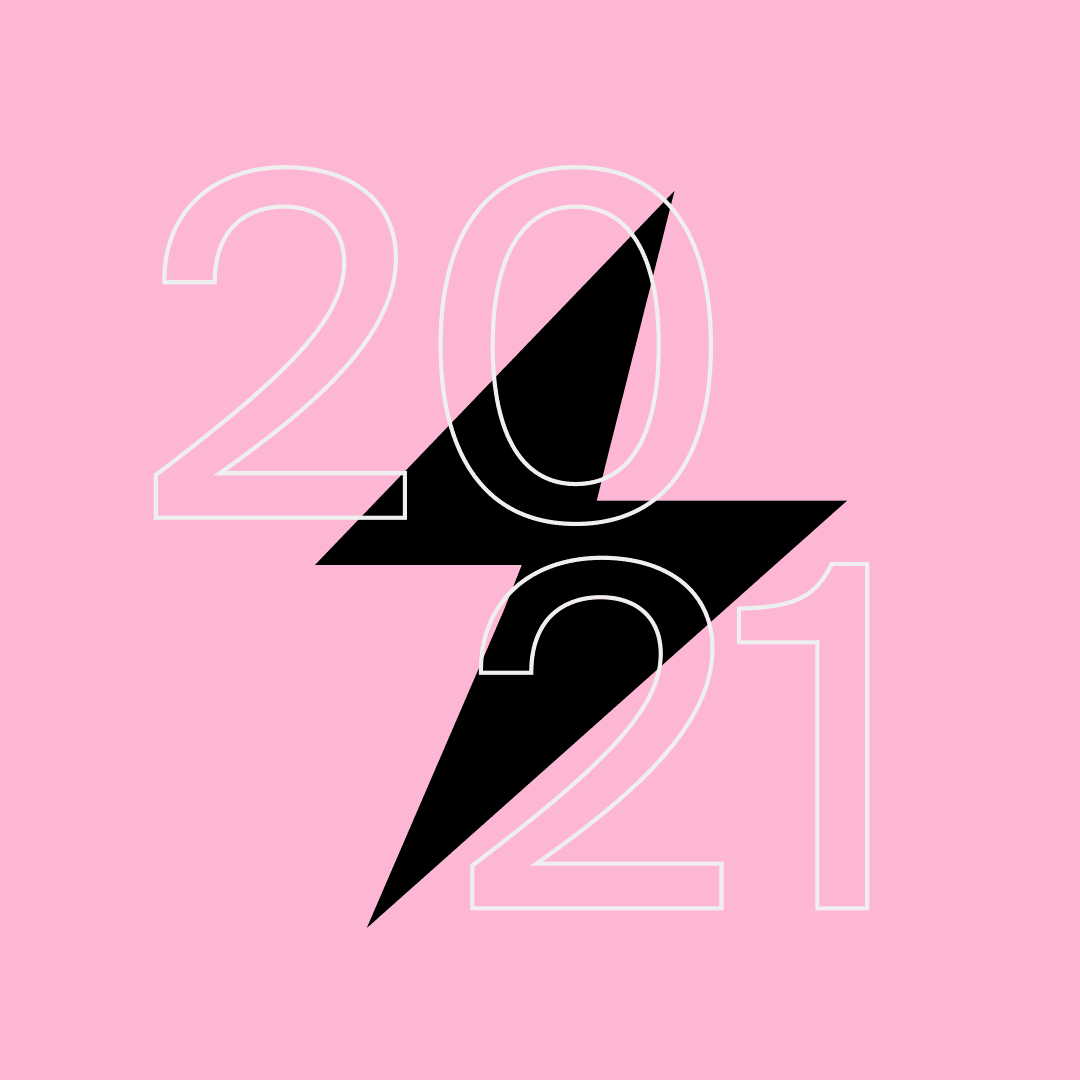
2020 has been a tough year, leading to many of us experiencing changes in our way of working, so there’s no doubt that many of us will want to enter the New Year with a refreshed mindset and outlook.
The turn of the year will be the perfect time to reinvent and capitalise on new, exciting ideas for your business, and a rejuvenation of your brand identity will play a crucial part in communicating these to your target audience.
To spark some inspiration, take a look at these top branding trends for 2021.
Maintain a human connection
In the era of video calls, socially distanced conversations, and working from home, brands have needed to work extra hard throughout 2020 to develop and nurture a human connection with their consumers, which will continue as a branding trend this year.
As we head into 2021, this branding trend will see consumers craving more interactions that aren’t solely through a screen as they seek out the faces and personality behind the brand. It is imperative for this branding trend that your brand shows a good level of character and clearly represents both your story and your values.
Trust is a significant component of human connection in the digital age, meaning brands should begin to build confidence and loyalty across their business. This branding trend is all about considering how you showcase privacy and data protection within your business!
Emphasise sustainability and activism
If 2020 has taught us anything, it’s the importance of sustainability and social justice, which will be another big branding trend in 2021. 51% of consumers said that ethical credentials were somewhat or very important when choosing apparel retailers, for example. This has resulted in businesses starting to adjust their focus to their social responsibility.
This branding trend involves a dedication to creating positive change on issues such as climate change, LGBTQ+ rights and Black Lives Matter, are all commitments that consumers have come to expect from brands and they can ultimately influence their purchasing decisions.
Making your logo and brand aesthetic overlap with your core values is a simple way to highlight this important branding trend, to make your views instantly recognisable while showing active support. Some businesses have even taken it a step further by incorporating their activism into their product range, by introducing sustainable packaging or donating a portion of their profit to local charities!
Work in nostalgia
The use of familiarity of the old, to sell the innovation of the new is a fun branding trend that can tie in nicely with the rest of your marketing campaign. When used correctly, nostalgia marketing can have a substantial effect on a consumer’s wellbeing and leads to a strong sense of purpose.
This branding trend is nothing majorly new but has been highlighted even further by the pandemic as people yearn for simpler things that remind them of their youth. This is especially prevalent in the online trend of cottagecore, which has really taken off during lockdown!
Capitalise on these branding trends today!
At BGN, we aim to maximise the effectiveness of your branding and execute a successful campaign across a variety of platforms. From web design and advertising campaigns to strategy planning and social media, our widely experienced team is both highly creative and results-driven to help you meet your business goals.
Ready to find out more? Get in touch with our team on 0161 808 4557 or info@bgn.agency to discuss how we can help.
Brand Purpose Examples: 3 of the Best from 2020

A brand’s purpose is arguably one of its most important aspects. It is an organisation’s reason for existence and expresses the values they stand for. It can make a significant impact on a business’s relationship with its consumers and when values align, it can lead to lifelong loyalty.
With 2020 being such a year of uncertainty, we’ve seen plenty of businesses revisiting their brand purposes and discovering more about the way they operate. The COVID-19 pandemic has seen the spotlight shone on them more than ever, and their decisions are being heavily scrutinised by customers.
Here, we take a look at the businesses that have maximised the impact of their brand purpose throughout the year and further aligned themselves with their target audience’s core beliefs.
1. The Body Shop
One of the first brand purpose examples we’ll look at is from The Body Shop. It looks to drive positive change and support causes that align with their target audience.
The Body Shop is no stranger to campaigning for social change. The trusted brand has gained supporters across the country through their passion for creating products that are environmentally sustainable and their efforts to raise awareness of difficult issues such as domestic violence.
This year, their efforts have been focused on supporting those affected by the Australian Bushfires. They have also donated products to support NHS workers working tirelessly to prevent the spread of COVID-19.
2. Airbnb
When a brand’s purpose directly ties into their everyday work, it appears much more authentic and packs a significant punch. Airbnb’s purpose is grounded in the experience of the users who visit the accommodation on their site.
However, with the recent pandemic affecting travel across the world, the company had to pivot quickly to showcase their purpose and find new ways to express good hospitality.
Hosts did this by offering free and discounted places to healthcare staff and frontline responders, so that they can stay close to their work while remaining socially distanced from their own families. Airbnb also added the option to ‘find a monthly stay’ on their site, which was ideal for key workers who needed semi-permanent accommodation.
3. Boots
Boots UK and Macmillan Cancer Support have a long, successful partnership that demonstrates the pharmacy chain’s dedication to making a difference to the lives of people living with cancer.
In-store staff provide access and support to those struggling with the illness as well as discussing concerns about medication and guiding people to other recommended sources of information. Due to the pandemic, Boots has made this service available digitally, with video consultation easy to book through their website.
The support doesn’t just end there, though. Boots have continually raised vital funds for those suffering from cancer by organising events such as raffles, make-up-athons, and pamper evenings.
Take note of these brand purpose examples and make your brand purpose meaningful with BGN
Don’t let your brand purpose sit dormant inspiring nobody. Ensure that it is acted upon in a clear, meaningful way and that it is motivating your audience, employees, and anyone else who comes into contact with your brand.
At BGN, we’ll do everything we can to fully express your core brand purpose and showcase your contribution to the world. Want to find out more? Get in touch with our team on 0161 808 4557 or info@bgn.agency to discuss your latest project and how we can help.
5 Signs You Really Do Need a New Website

Every business wants to have a sleek, professional and on-trend website that both attracts and engages consumers. But what can be the telling signs you need a new website?
Creating a new website can be a big undertaking and often requires an investment in both time and money, so it’s crucial to know if you’re making the right move at the right time.
Some of the signs you need a new website are glaringly obvious, whereas some will be a little subtler. However, all of the signs listed below are ones you must look out for to ensure you stay ahead of the game and provide the best experience for your customers.
High bounce rates
Bounce rate is a metric that measures the number of visitors who enter your website and then leave rather than continuing to view other pages. This could be for several reasons but tends to be because they find the website too difficult to use, too slow or they struggled to find what interested them.
A fresh redesign may solve this issue and convince users to stick around. Review your content throughout the site to ensure its relevant and engaging, then ensure the overall site navigation is user friendly. If not, it could be a deal-breaker for site visitors.
Outdated information
Another one of the signs you need a new website is if your website contains a lot of errors, inconsistencies, or old, useless content, it will leave users uninterested. At worst, some users may even consider your site spam.
Whether it be advertising events that have already happened, listing staff members that have moved on or showcasing products that are no longer for sale, a website containing a lot of blatant errors means you are well overdue a refresh.
Search engine rankings are low
Older sites tend to carry a lot of duplicate pages and often lack an effective keyword strategy, which ultimately means they won’t rank highly in a Google search.
Customers tend to rely on searching within Google rather than entering a specific domain name. So, if your website isn’t appearing in the top five search engine results, then chances are you’re missing out on a lot of new traffic to the site.
Slow page loading speeds
People have become rightly accustomed to having things when they want it online. Older sites or websites with an excessive number of graphics or large files sizes will experience frequent lagging. This will likely frustrate the customer and eventually drive them elsewhere.
Good web design requires a balanced mix of text, images, video and interactivity that doesn’t interrupt the flow of the website for the user or delay it’s loading speeds.
It doesn’t align with your branding
Now more than ever, your website is your primary marketing tool. It needs to be consistent with the rest of your branding as it essentially acts as the shop window for your entire business.
If you have strict brand guidelines for colours, fonts and style, be sure to stick to them. Otherwise, your website will come off as disingenuous and awkward in comparison to the rest of your brand. A brand that claims to be forward-thinking and professional needs to have a website which reflects that.
Spotted signs you need a new website? Create a new website today with BGN
Understanding when you need a new website is an essential step towards developing your brand. You should be proud to show off your site and believe it is a good representation of your company as a whole.
BGN are a strategic design agency in Manchester that will help you develop a brand new website that’s fit for purpose and aligned with the rest of your business goals.
Want to find out more? Get in touch with our team on 0161 808 4557 or email us at info@bgn.agency to find out how we can help improve your current site.
Balancing Your Brand: When Promise & Experience Don’t Align
For many businesses, branding is about what you say and show to customers. Your brand image, in other words. But in fact, it runs much deeper than that. Branding is actually the identity you give to your business.
For it to really work, what customers experience (what you’re doing) needs to match your promise (what you’re saying and showing). When there isn’t a balance between the two, problems are not far away…
What is your promise?
While you might not realise it, every brand has a promise. It’s what you offer customers on your website, in adverts or through printed marketing materials like leaflets and business cards. And it can be explicit or implicit.
Explicitly, your company’s tagline might focus on being hassle-free for customers. Implicitly, your design could be sleek and modern, hinting at innovative products or services, for example.
What about experience?
Much like promise, every brand has an experience. It’s pretty much every interaction and encounter customers have with your business. While the quality of your products or services are a big part of this, they’re not the only component.
Stepping into your store, visiting your website, speaking to a member of your team. It all contributes to the overall brand experience.
The problem for some brands is that their promise and experience don’t align. They might put themselves out there as a customer-centric company, for example, then leave customers on hold for hours or leave them wandering around their store waiting for assistance. The result is a false promise.
Customers are given an expectation for your brand which simply isn’t delivered.
So why does this happen? In many cases, it’s down to a narrow focus on the promise. Companies see branding as a way of changing and improving the promise. But all too often, they don’t change the experience too.
That’s reflected in the 2018 Brand Experience Report from the Chartered Institute of Marketing. They found that two thirds of marketers think their senior leadership teams fail to fully embed brand values throughout their organisation and relationship with customers.
Finding the right balance
Creating a balance between your brand’s promise and experience is key to an effective branding project. Fortunately, there are a few steps you can take to achieve it..
1. AGREEMENT –
First and foremost, make sure everyone agrees on the task at hand. You need confirmation from the very top of your business that this project is something they’re committed to in terms of time, money and human resources.
2. CLARITY –
Everyone in your business needs to know exactly what the brand promise is and how they can contribute to the experience. This is where a physical document like brand guidelines can help.
3. COMMITMENT –
The brand promise needs to manifest in every corner of your business. From customer service and complaints handling to the user experience on your website, everything should align.
4. MONITORING –
You’ll need to keep track of how your promise and experience are working. The perfect balance won’t happen overnight, so be prepared to make tweaks on both sides of the scales.
Developing and delivering your brand
At BGN, we’re specialists not only in developing brands – but in executing and delivering them across all platforms. From web design, social media and advertising campaigns to strategy planning and onboarding, we’ll work with you to make sure your promise and experience align across the board.
Want to find out more? Get in touch with our team on 0161 808 4557 or info@bgn.agency to talk about your project and how we can help.
Time flies when you’re having fun
Check out how our designer, Francie Martinez, got into the creative industry and her advice for recent graduates here👇
Where were you before BGN?
I graduated from Kingston University with a BA in Graphic Design. I then interned at NB Studio and Johnson Banks, two award winning design agencies that gave me a taste of what it’s like to work in industry.
Why did you get into design?
From a young age I was always making and drawing things using scraps of whatever I could find around the house. Despite no one in my family having a creative background, I always gravitated towards it.
Whats it like to be a designer at BGN?
Super fun! I get to work on loads of different projects and learn a lot along the way, it’s an added bonus that the team at BGN are so supportive.
What have been your favourite projects so far?
It’d have to be Silkies which is a Silk product brand launching in November. Through Silkies, our client, Mai will also be working with charities that support young girls in Mexico. It’s the first project I’ve been able to see through from start to finish and it’s this branding process that I’ve found myself wanting more of!
What sources do you use for inspiration?
I do find myself scrolling through Instagram a lot, some of my favourite accounts at the moment are @femmetype @pablo.rochat @morrre.dsgn and @icographica there’s also a bunch of websites I like to flick through as well. But I think it’s also important to just go on a big long walk sometimes and see what inspiration can be found in more unexpected places.
Whats your favourite brand?
I attended a virtual talk at the beginning of lockdown (mad times) where Paula Scher talked about The Mental Health Coalition, a collaborative platform used to de-stigmatize mental health conditions. Besides the bright and bold coloured identity, I liked how this project was mentioned after discussing the balance between working for money or working for free. Not that I’m all for working for free, but it was just really nice to see someone so passionate about a topic and roll it out in a super short time frame for a nonprofit organisation.
What advice would you give to recent graduates?
Stick at it, if it’s what you really want! After graduating I was juggling three jobs to help fund living in London, and at the same time was well into my overdraft upon graduating.
On top of that I was trying to find the time to email studios, send printed work out, follow up with phone calls and keep my portfolio updated with new work. The hardest part for me was staying motivated because at that point you feel like you’re constantly working towards something that might never happen. But now that things have worked out for me, my advice would be to carry on and try your best, it’s going to work out eventually.
Oh and try to mix it up when applying for internships, after all the emails, printed pieces and phone calls, I actually got my first internship after speaking to a friend on my course who referred me.





























